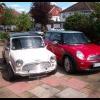
Crashing A Mini
#46

Posted 30 August 2011 - 03:59 PM
#47

Posted 30 August 2011 - 04:09 PM
What a great video, Ive been looking for something like this for a while. Do you know of any more ?http://fwd.channel5....t-vs-iq-vs-mini = in this they test a toyota and a smart car vs a mini, and the mini wins, BUT then they crash it into a lexus =/
#48

Posted 30 August 2011 - 08:28 PM
A lot of those posting seem to see the Mini as unsafe at any speed.
I totally disagree and over the years I've seen how strong a good rust-free Mini bodyshell really is. It is a classic 'box' shape which, in structural design terms is good. The sheet metal is thicker than that of, say, a Citroen Saxo, for example, and the Mini's structure does deform progressively. With a grp front end it may be a different matter, but that's personal choice in the end.
Yes, modern cars designed using full CAD/CAM techniques are probably stronger in certain crash cases, but not necessarily all cases.
The real answer is not to drive in a manner which makes crashing likely in the first place. That applies to any car.
#49

Posted 30 August 2011 - 08:34 PM
Yeah at the end of the day if you drive sensibly you should be alright. I think we just have to accept the fact that minis really rant that safe and roll cages will help the structure of the car in a crashIn 'Technical' there is a thread about how to make a Mini safer.
A lot of those posting seem to see the Mini as unsafe at any speed.
I totally disagree and over the years I've seen how strong a good rust-free Mini bodyshell really is. It is a classic 'box' shape which, in structural design terms is good. The sheet metal is thicker than that of, say, a Citroen Saxo, for example, and the Mini's structure does deform progressively. With a grp front end it may be a different matter, but that's personal choice in the end.
Yes, modern cars designed using full CAD/CAM techniques are probably stronger in certain crash cases, but not necessarily all cases.
The real answer is not to drive in a manner which makes crashing likely in the first place. That applies to any car.
#50

Posted 30 August 2011 - 09:06 PM
#51

Posted 30 August 2011 - 09:08 PM
Jesus you were lucky to survive ...did the cab pull out on you?
Glad your ok by the way!!!
Technically the accident was my fault as I was the one that pulled out onto the "main" road. In my defence (and this is what the police said) there were no visual clues to say that a crossroads was coming up - the road markings were completely worn away and the give way sign was in an overgrown hedge. After the accident I didn't know what had happened - I thought maybe I had gone to pull out and the cab driver came speeding round the corner (the cab was in a 30 limit by the way - I'll leave you to decide whether it was doing 30 or not!) but the witnesses say that I didn't see it in time and overshot the crossroads. I'm looking into whether I have a case against the highways agency or not because they were negligent in the maintenance of the road markings etc. but I'm not banking on it as I imagine they would have very expensive lawyers!
In 'Technical' there is a thread about how to make a Mini safer.
A lot of those posting seem to see the Mini as unsafe at any speed.
I totally disagree and over the years I've seen how strong a good rust-free Mini bodyshell really is. It is a classic 'box' shape which, in structural design terms is good. The sheet metal is thicker than that of, say, a Citroen Saxo, for example, and the Mini's structure does deform progressively. With a grp front end it may be a different matter, but that's personal choice in the end.
Yes, modern cars designed using full CAD/CAM techniques are probably stronger in certain crash cases, but not necessarily all cases.
The real answer is not to drive in a manner which makes crashing likely in the first place. That applies to any car.
I agree with the importance of having a rust free bodyshell, I shudder to think how many people are driving around with oversills on blissfully unaware that their car may fold up in a head-on collision. However, I think the problem with the design of the mini bodyshell is that the front end is very strong from the bulkhead forwards, but the passenger cell is far weaker with it's very thin pillars and the subframe tends to push the floor up.
#52

Posted 30 August 2011 - 09:14 PM
I wouldn't worry about highways agency (or Council depending on the road) lawyers , it's a public body with a duty to act in the public interest, not defend all claims against them regardless. I imagine they'd have to show evidence of maintenance & inspection schedules to argue they have no liability for the junction not being up to scratch.
#53

Posted 30 August 2011 - 10:10 PM
had that shell not been as solid as it was, well, youd have faired a damn site worse. all the welds on it were still holding when i had a look round it.Here is a pic of it once I stripped it of anything useful. Looking around the car it was amazing how the whole body had twisted. It even caused most of the fuel tank clips to pop out, which on an estate hangs at the very back of the car. At the front the teardrops mounts were about a foot from where they were meant to be. It hasn't put me off minis at all because I've always known that they won't stand up as well as a 60 plate Renault in an accident! It just means that you've got to be on the ball at all times. I think young people in more modern cars need to realise that too - so many are under this subconscious illusion that because they have airbags, ABS, crumple zones etc. that they can drive however they like. They need big spikes pointing out of their steering wheel, not airbags!
#54

Posted 30 August 2011 - 10:21 PM

Edited by samsfern, 30 August 2011 - 10:24 PM.
#55

Posted 30 August 2011 - 10:41 PM
heres one i rolled a few times, after a balljoint failed at 70mph+, i think it shaved a bit of speed off whilst it was spinning in the road, before hitting a grass bank and rolling into a field. this was a few years ago. didnt do too badly, the body was very distorted though. there was no roll cage or harnesses fitted, my seatbelt broke with the impact, i even had an air ambulance land in the same field, as well as a fire engine, two police cars and an ambulance. i was fine, just a tad achy the next day.
Looks like you were lucky there ( Did you get air lifted ) . The car looks surprisingly good considering its been rolled a few times
#56

Posted 30 August 2011 - 10:48 PM
Edited by samsfern, 30 August 2011 - 10:50 PM.
#57

Posted 31 August 2011 - 10:56 AM
As for no evidence existing as to their effectiveness in a road car, I believe that some research has been undertaken and that some evidence does exist. I'm not able to reference it directly, but I dare suggest that if you search for long enough on the net then, you will find some.
Many insurers substantially increase your premium if you fit a roll cage to a road car. Some here will argue that this is because insurers view them as a performance modification and that they believe you to be more likely to have an accident if you are the type of person who will fit one. However the insurers I have spoken to justify the premium increase simply because of the increased risk of injury to occupants caused by fitting one. Similarly I understand that fitting autosport "collision cages" to road cars has been outlawed in a number of US states for the same reason. Again some will argue that this was part of a wider political motives from the US motor industry to limit after market modifications instead though. Also consider that modern vehicle design has tried to design out exposed bare metal work in the passenger compartment for many years, due to the risks it poses to occupants.
The successful use of roll cages in motorsport (both track and rally use) is probably not the most accurate of comparisons to a road car either. Motorsport is a very different and much more controlled environment to normal driving conditions with very different risks and hazards involved.To mention but a few, the vehicles involved are usually only travelling in one direction in motorsport, the other safety constraints used alongside the roll cage are much higher, the emergency services are usually immediately on hand in the event of a incident and the risk of the vehicle rolling over and leaving the track is also very high. Ultimately in that environment the benefit of having a roll cage fitted far outweighs the hazards that it may present.
One final point is that you need to consider that serious and fatal injuries from road traffic collisions are not always as a result of intrusion into the passenger compartment. The level of visible damage to the vehicle is not always a good indicator as to the severity of the injuries of the occupants inside. I have extricated injured people from road traffic collisions for many years, in that time I have seen people walk away virtually unscathed from wrecks that you could not possibly believe anybody to have survived. By contrast I have also seen many fatalities from vehicles with minimal physical damage. A roll cage will only protect the occupants from injuries sustained from intrusion into the vehicle, it will not stop the often fatal internal injuries caused by the sudden deceleration forces acting upon the body. If anything it will compound these forces as it will reduce the shells ability to absorb them.
My suggestion on all these points is that you do your own research and draw your own conclusions. If you still feel that you need a roll cage in your car then you should probably fit one, just do not be under the illusion that they are some kind of a "miracle cure" to vehicle safety.
#58

Posted 31 August 2011 - 11:14 AM
At the end of the day you have to ask yourself, why do none of the manufactures fit roll cages to road cars? They spend millions each year improving safety in cars and looking for new ways to save lives. Driving on the road and motorsport can't really be compared.
Minis will never fare as well as a modern car in a crash, due to their size, shape, age of design etc. but they aren't the death traps some people think they are.
#59

Posted 31 August 2011 - 11:26 AM
So, yes, if you are in a road accident which involves the car rolling, and if you have full harness belts and seats which will not break away from the structure, then your chance of avoiding serious injury is probably better.
A roll-cage is part of an integrated safety system which includes the seats, belts, plumbed-in fire extinguisher, restraining of 'stuff' inside the car like luggage, shopping, bits & pieces, etc.
There is little point in having a cage if you still have lap & diagonal belts and standard seats (which will not be restrained in a big crash). Even after-market so-called 'bucket seats' may not be be an advantage unless they have FIA approval and are mounted to motorsport regulations. This makes your Mini a 2-seater only as the seats are bolted in. They would even have to be unbolted to adjust for a different driver.
Edited by Cooperman, 31 August 2011 - 12:06 PM.
#60

Posted 31 August 2011 - 11:57 AM
At the end of the day you have to ask yourself, why do none of the manufactures fit roll cages to road cars?
They may not fit visible roll cages but modern cars have far thicker reinforced roof pillars and a strong survival cell structure built in to the bodyshell, however as stated they have also designed the rest of the surrounding non-passenger cell body structures to form crumple zones which absorb and dissipate as much crash energy as possible before it reaches the bodies of the vehicle occupants, all in conjunction with multiple airbags. It should also be remembered that much damage can be done to the human body by internal organs impacting your skeleton and whiplash can kill without suitable correctly adjusted head restraints. Nearly all racing drivers (including Mini 7) now wear F1 style head/neck restraints because the additional weight of a crash helmet has killed many drivers instantly in the recent past due to whiplash forces breaking their neck...........
1 user(s) are reading this topic
0 members, 1 guests, 0 anonymous users



















